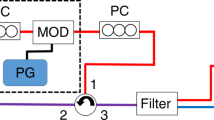Abstract
Hybrid interfaces between semiconductor quantum dots and atomic systems could be of potential fundamental and technological interest, because they can combine the advantages of both constituents. Semiconductor quantum dots are tunable and deterministic sources of single1 and entangled photons2. Atomic vapours are widely used as slow-light media3,4 and quantum memories5,6. Merging both systems could enable the storage of quantum dot emission—an important step towards the implementation of quantum memories and quantum repeaters7. Here, we show a hybrid semiconductor–atomic interface for slowing down single photons emitted from a single quantum dot. We use a double absorption resonance4 in rubidium vapour to create a slow-light medium in which a single photon is stored for 15 times its temporal width. Our result is the first demonstration of non-classical light storage, where single photons are generated on demand from a semiconductor source.
This is a preview of subscription content, access via your institution
Access options
Subscribe to this journal
Receive 12 print issues and online access
$209.00 per year
only $17.42 per issue
Buy this article
- Purchase on Springer Link
- Instant access to full article PDF
Prices may be subject to local taxes which are calculated during checkout



Similar content being viewed by others
References
Michler, P. et al. A quantum dot single-photon turnstile device. Science 290, 2282–2285 (2000).
Akopian, N. et al. Entangled photon pairs from semiconductor quantum dots. Phys. Rev. Lett. 96, 130501 (2006).
Hau, L. V., Harris, S. E., Dutton, Z. & Behroozi, C. H. Light speed reduction to 17 metres per second in an ultracold atomic gas. Nature 397, 594–598 (1999).
Camacho, R. M., Pack, M. V., Howell, J. C., Schweinsberg, A. & Boyd, R. W. Wide-bandwidth, tunable, multiple-pulse-width optical delays using slow light in cesium vapor. Phys. Rev. Lett. 98, 153601 (2007).
Liu, C., Dutton, Z., Behroozi, C. H. & Hau, L. V. Observation of coherent optical information storage in an atomic medium using halted light pulses. Nature 409, 490–493 (2001).
Phillips, D. F., Fleischhauer, A., Mair, A., Walsworth, R. L. & Lukin, M. D. Storage of light in atomic vapor. Phys. Rev. Lett. 86, 783–786 (2001).
Briegel, H.-J., Dür, W., Cirac, J. I. & Zoller, P. Quantum repeaters: the role of imperfect local operations in quantum communication. Phys. Rev. Lett. 81, 5932–5935 (1998).
Boller, K.-J., Imamolu, A. & Harris, S. E. Observation of electromagnetically induced transparency. Phys. Rev. Lett. 66, 2593–2596 (1991).
Chanelière, T. et al. Storage and retrieval of single photons transmitted between remote quantum memories. Nature 438, 833–836 (2005).
Eisaman, M. D. et al. Electromagnetically induced transparency with tunable single-photon pulses. Nature 438, 837–841 (2005).
Bajcsy, M. et al. Efficient all-optical switching using slow light within a hollow fiber. Phys. Rev. Lett. 102, 203902 (2009).
Slepkov, A. D., Bhagwat, A. R., Venkataraman, V., Londero, P. & Gaeta, A. L. Spectroscopy of Rb atoms in hollow-core fibers. Phys. Rev. A 81, 053825 (2010).
Wu, B. et al. Slow light on a chip via atomic quantum state control. Nature Photon. 4, 776–779 (2010).
Akopian, N. et al. Tuning single GaAs quantum dots in resonance with a rubidium vapor. Appl. Phys. Lett. 97, 082103 (2010).
Ashoori, R. C. Electrons in artificial atoms. Nature 379, 413–419 (1996).
Poem, E. et al. Polarization sensitive spectroscopy of charged quantum dots. Phys. Rev. B 76, 235304 (2007).
Harris, S. E., Field, J. E. & Kasapi, A. Dispersive properties of electromagnetically induced transparency. Phys. Rev. A 46, R29–R32 (1992).
Bayer, M. et al. Fine structure of neutral and charged excitons in self-assembled In(Ga)As/(Al)GaAs quantum dots. Phys. Rev. B 65, 195315 (2002).
Bouwmeester, D. et al. Experimental quantum teleportation. Nature 390, 575–579 (1997).
Kübler, H., Shaffer, J. P., Baluktsian, T., Löw, R. & Pfau, T. Coherent excitation of Rydberg atoms in micrometre-sized atomic vapour cells. Nature Photon. 4, 112–116 (2010).
Rastelli, A. et al. Hierarchical self-assembly of GaAs/AlGaAs quantum dots. Phys. Rev. Lett. 92, 166104 (2004).
Acknowledgements
The authors acknowledge U. Perinetti, M. Koole and J. van Leeuwen for their help in the early stages of the project. The authors also thank L. Kouwenhoven for support and useful discussions. O. Benson and D. Hoeckel are acknowledged for their help with the vapour cell temperature control, and E. Zallo, R. Trotta, P. Atkinson and C. Deneke for their contributions to sample preparation. This work was supported by the Dutch Organization for Fundamental Research on Matter (FOM), The Netherlands Organization for Scientific Research (NWO Veni/Vidi), the German Research Foundation (DFG FOR 730) and the Federal Ministry of Education and Research (BMBF QK_QuaHL-Rep, 01BQ1032).
Author information
Authors and Affiliations
Contributions
The experiments were conceived and designed by N.A. and V.Z. and carried out by N.A. The data were analysed and modelled by N.A. The sample was developed by L.W., A.R. and O.G.S. The manuscript was written by N.A. and V.Z. with input from A.R. and O.G.S.
Corresponding author
Ethics declarations
Competing interests
The authors declare no competing financial interests.
Supplementary information
Supplementary information
Supplementary information (PDF 591 kb)
Rights and permissions
About this article
Cite this article
Akopian, N., Wang, L., Rastelli, A. et al. Hybrid semiconductor-atomic interface: slowing down single photons from a quantum dot. Nature Photon 5, 230–233 (2011). https://doi.org/10.1038/nphoton.2011.16
Received:
Accepted:
Published:
Issue Date:
DOI: https://doi.org/10.1038/nphoton.2011.16
This article is cited by
-
Quantum-dot-based deterministic photon–emitter interfaces for scalable photonic quantum technology
Nature Nanotechnology (2021)
-
Coherent interaction of atoms with a beam of light confined in a light cage
Light: Science & Applications (2021)
-
Quantum teleportation with imperfect quantum dots
npj Quantum Information (2021)
-
Resonant excitation of nanowire quantum dots
npj Quantum Information (2020)
-
High–temperature droplet epitaxy of symmetric GaAs/AlGaAs quantum dots
Scientific Reports (2020)



